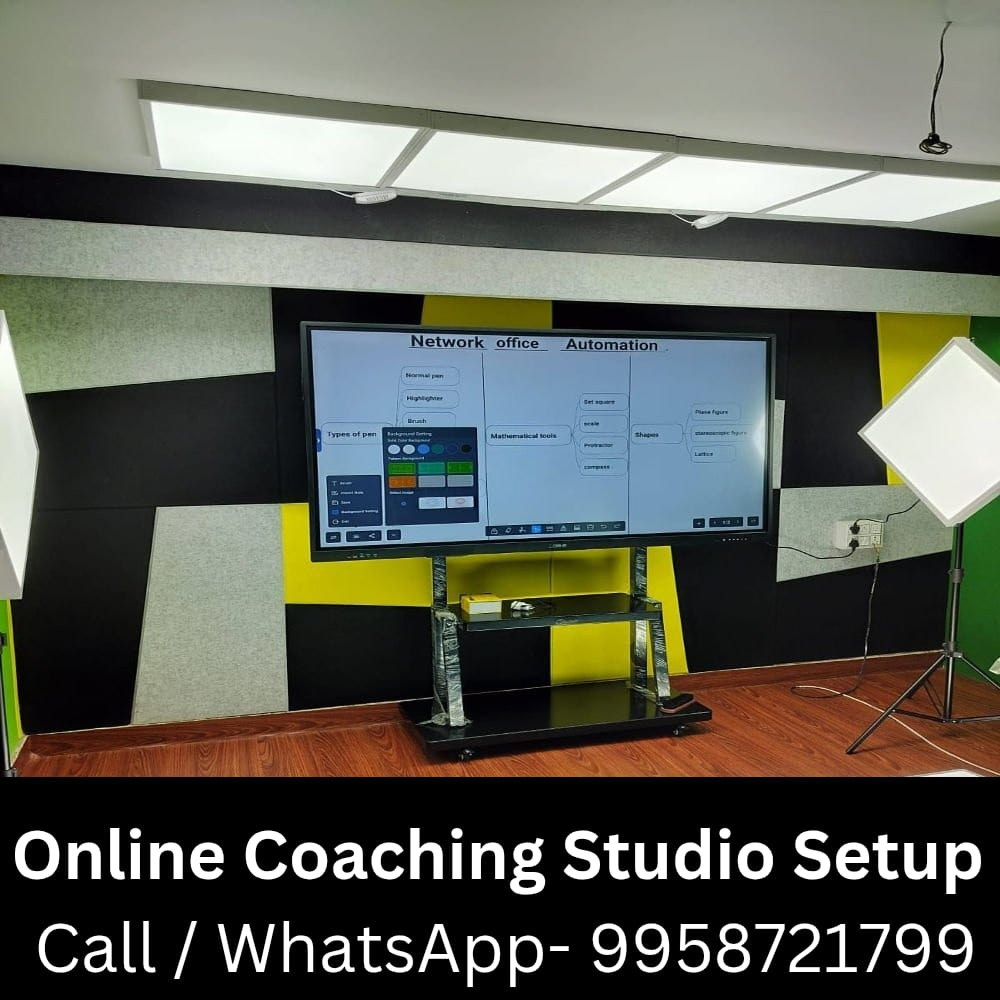Call / WhatApp (To Install Digital Studio) – Click Here
In today’s digital age, online coaching has evolved from a convenient option to a powerful industry standard. Whether you’re a fitness instructor, life coach, music teacher, or corporate trainer, setting up your own online coaching studio allows you to reach a global audience, build your brand, and deliver professional-quality sessions—all from the comfort of your space.
This guide walks you through every step of creating a high-performing online coaching studio—from planning and equipment setup to branding and delivery.
1. Define Your Coaching Niche and Goals
Before investing in equipment, start by defining what you want to teach and who your audience is. Clarity here shapes every other decision.
- Identify your niche: fitness training, academic tutoring, mindset coaching, skill development, etc.
- Set goals: live classes, recorded content, one-on-one sessions, or group programs.
- Choose your model: subscription-based, pay-per-session, or hybrid.
A focused niche helps you tailor your studio design, technology, and content strategy effectively.

Call / WhatApp (To Install Digital Studio) – Click Here
2. Choose the Right Space
Select a quiet, well-lit, and distraction-free area for your studio. Consider:
- Soundproofing: Use foam panels or curtains to reduce echo and background noise.
- Lighting: Natural light is ideal; supplement with LED softboxes or ring lights for clarity.
- Backdrop: Keep it clean and professional. A plain wall, brand banner, or digital background works well.
A visually appealing and quiet space immediately builds credibility with clients.
Call / WhatApp (To Install Digital Studio) – Click Here
3. Invest in Essential Equipment
Professional quality doesn’t require expensive gear, but it does require the right gear.
Basic Setup Checklist:
- Camera: A good HD webcam (e.g., Logitech Brio) or DSLR for premium quality.
- Microphone: USB condenser mics (e.g., Blue Yeti or Rode NT-USB) offer clear sound.
- Lighting: Two softbox lights or a ring light for even illumination.
- Tripod/Stand: Keep your camera stable at eye level.
- Computer & Internet: Reliable laptop/PC and at least 20 Mbps upload speed.
Optional additions include a green screen, external monitor, or sound mixer for more advanced production.

4. Select the Right Coaching Platform
The platform determines how you interact, record, and monetize your sessions.
Popular Options:
- For live sessions: Zoom, Google Meet, Microsoft Teams.
- For course creation: Teachable, Thinkific, Kajabi, or Podia.
- For fitness or performance-based coaching: Trainerize, TrueCoach, or Mindbody.
Ensure the platform allows:
- HD streaming and recording
- Payment integration
- Scheduling tools
- Branding customization
- Client management and analytics
Call / WhatApp (To Install Digital Studio) – Click Here
5. Create a Professional Brand Presence
Your online coaching studio isn’t just about teaching—it’s about building trust and recognition.
Branding Essentials:
- Logo, color scheme, and typography
- A professional website with clear service details
- Engaging social media profiles
- Consistent tone of communication across all channels
Add testimonials, case studies, and demo videos to showcase your expertise.
Call / WhatApp (To Install Digital Studio) – Click Here
6. Streamline Your Workflow
Efficiency makes your sessions smoother and your business scalable.
- Use calendaring tools (Calendly, Acuity) for scheduling.
- Automate emails and reminders via CRM tools (HubSpot, Mailchimp).
- Set up cloud storage (Google Drive, Dropbox) for resource sharing.
- Maintain recordings and notes for client tracking.
Call / WhatApp (To Install Digital Studio) – Click Here
7. Optimize for Engagement and Quality
Delivering great coaching sessions online takes more than good content—it requires interactivity and reliability.
Tips for Better Sessions:
- Start with clear objectives and structure.
- Use visuals and slides to keep learners engaged.
- Encourage participation through Q&A, polls, and feedback.
- Record sessions for playback or future marketing content.
Regularly update your materials to stay relevant and dynamic.
8. Market Your Online Coaching Studio
Once your studio is ready, it’s time to attract clients.
Effective Marketing Strategies:
- Launch with a free webinar or introductory workshop.
- Build an email list through lead magnets (e.g., free eBook or checklist).
- Run social media ads targeting your niche.
- Collaborate with influencers or communities in your domain.
- Ask for referrals and testimonials from satisfied clients.
Consistency in marketing builds trust and drives long-term growth.
9. Ensure a Smooth Client Experience
Your client’s journey—from discovery to delivery—should feel seamless.
- Offer easy payment options (PayPal, Stripe).
- Send pre-session instructions and post-session feedback.
- Provide recorded sessions or learning materials.
- Maintain open communication channels.
A positive client experience encourages retention and referrals.
Call / WhatApp (To Install Digital Studio) – Click Here
10. Keep Evolving
Technology and trends change rapidly in the digital coaching world. Stay updated with:
- New streaming tools and platforms
- AI-powered coaching aids
- Interactive whiteboards and analytics tools
- Online learning trends (microlearning, gamification, etc.)
Constant improvement helps you stay competitive and relevant.
Conclusion
Setting up an online coaching studio is an empowering step toward professional independence and global impact. With thoughtful planning, the right tools, and consistent branding, you can create a studio that not only looks professional but also delivers real value to your clients.
Whether you’re launching a small solo setup or scaling into a full-fledged online coaching brand, remember: authenticity and quality are your best marketing tools.
Call / WhatApp (To Install Digital Studio) – Click Here


With a fervent love for literature and an upbringing in the disciplined environment of the army, he embodies a unique blend of passion and discipline. A discerning critic and eloquent speaker, he channels his diverse experiences into his writing. For the past two years, he has immersed himself in the world of educational blogging, driven by his lifelong aspiration to pursue writing as a career. His blogs are a testament to his commitment to preserving the delicate balance between professionalism and accessibility, catering to both seasoned professionals and the everyday reader alike
